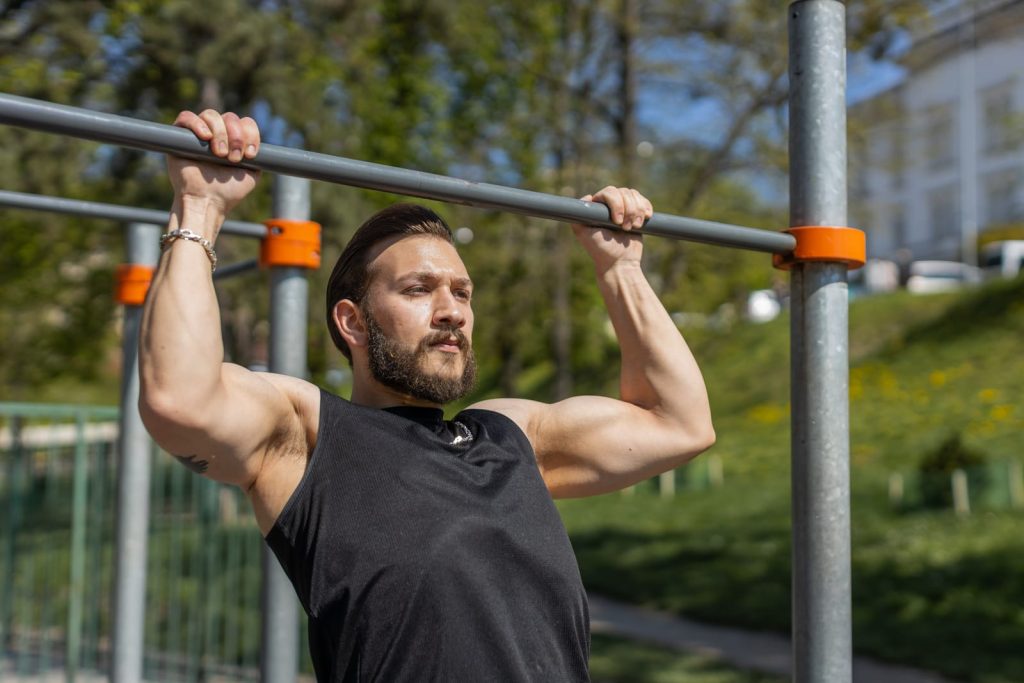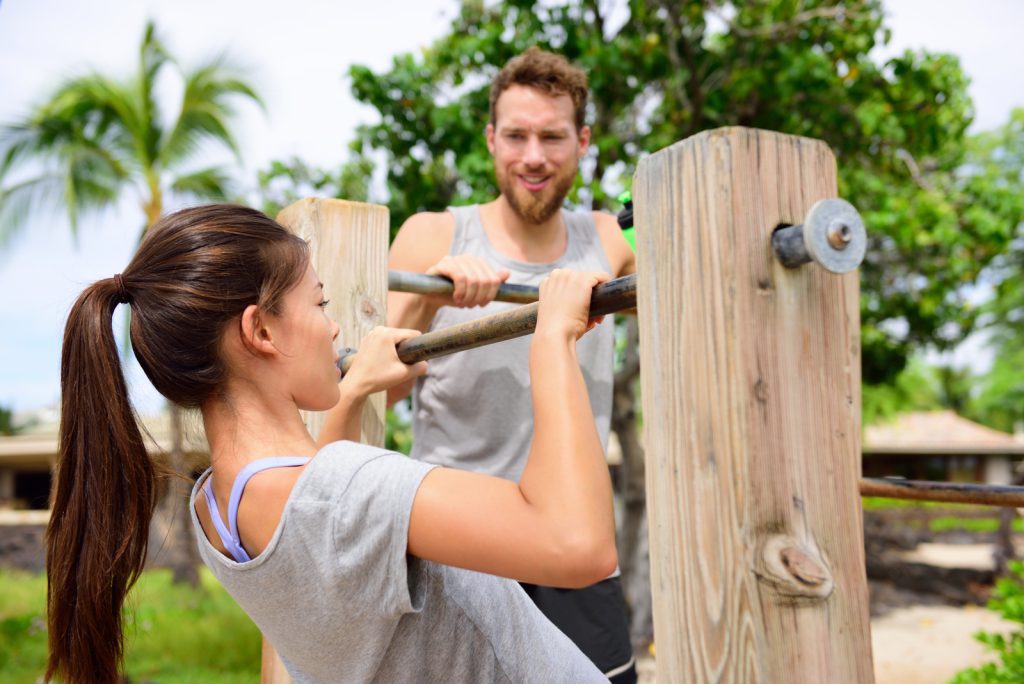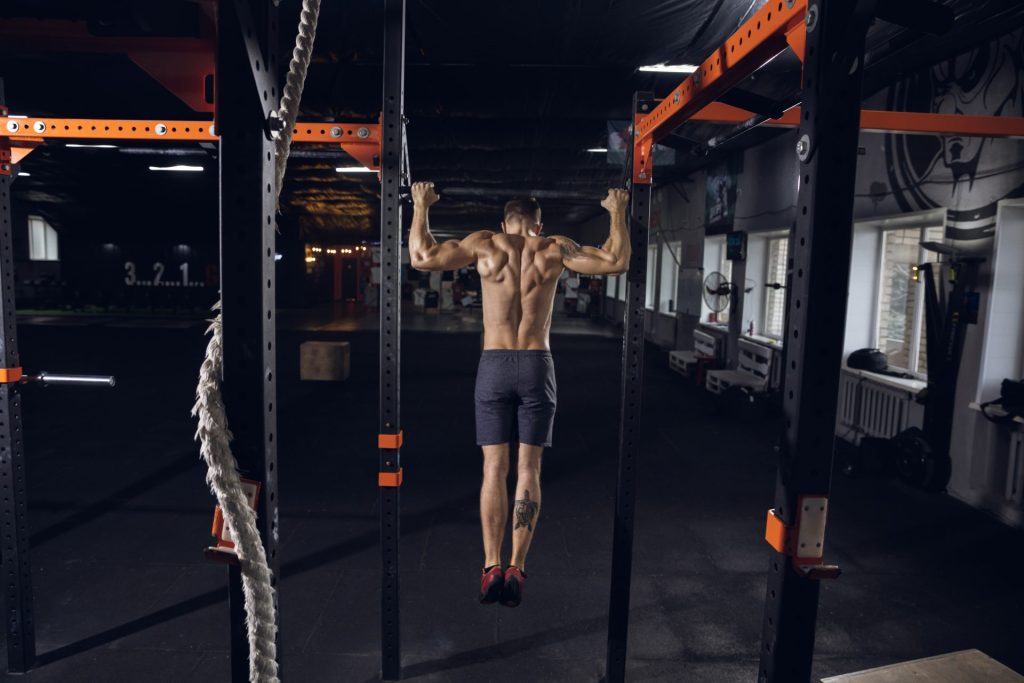In the fitness world, few exercises command the same level of respect as the pull-up. The pull-up, often hailed as the “king of upper body exercises,” has earned its reputation for good reason. But did you know that this seemingly simple movement comes in various forms, each with its own benefits and muscle-targeting nuances?
Whether you’re striving to build a powerful back, sculpt well-defined arms, or enhance your overall upper body strength, understanding the array of pull-up variations at your disposal is key.
Get ready to explore what muscles do pull-ups work—where precision meets perseverance, and gains are forged rep by rep.
Contents
All Types of Pull-Ups and What They Work
Standard Pull-Up
The standard pull-up is a fundamental upper body exercise that primarily engages the lats, biceps, and upper back muscles. Executed using an overhead bar, it forms the cornerstone of an effective strength training routine.
Muscles Targeted:
- Latissimus Dorsi (Lats): The primary muscle worked during a pull-up, the lats are responsible for the pulling motion, aiding in shoulder extension and adduction.
- Biceps Brachii: The biceps play a significant role as secondary movers, assisting the lats in pulling the body upwards.
- Upper Back Muscles: The rhomboids, trapezius, and rear deltoids stabilize and contribute to the movement, promoting better posture and back strength.
Proper Execution and Technique Tips
- Grasp the overhead bar with a slightly wider than shoulder-width grip, palms facing away (pronated grip).
- Hang fully extended, feet off the ground, and engage your core.
- Begin the movement by retracting your scapulae (shoulder blades) and pulling your elbows down and back.
- Continue pulling until your chin is above the bar, maintaining a controlled motion.
- Lower your body in a controlled manner, fully extending your arms before beginning the next repetition.
Technique Tips:
- Maintain a neutral spine throughout the movement.
- Focus on controlled movements; avoid using momentum.
- Breathe in as you lower your body and exhale as you pull up.
- Engage your core to prevent excessive swinging.
Wide Grip Pull-Up
Wide Grip Pull-Up Technique
- Start with a bar that is wider than shoulder-width apart. Grasp the bar with palms facing away (overhand grip), ensuring your hands are slightly wider than your shoulders.
- Initiate the movement by engaging your core muscles. This stabilizes your body and prevents excessive swinging.
- Begin the pull-up by retracting your shoulder blades. This action activates the outer back muscles, especially the latissimus dorsi.
- Pull your body up by flexing the elbows. Focus on driving your elbows down and towards your hips to emphasize the outer back and shoulders.
- Lower your body back down with control. Avoid letting your body drop abruptly, as this can lead to injury.
Targeted Benefits: Sculpting a V-Shaped Torso
- The wide grip pull-up effectively isolates the outer back muscles, promoting balanced growth and definition in the latissimus dorsi.
- This exercise places significant emphasis on the rear deltoids and the teres major, enhancing the overall width and strength of the shoulders.
- Incorporating wide-grip pull-ups into your routine contributes to achieving a coveted V-shaped torso, accentuating the upper body’s aesthetic appeal.
Chin-Up
The chin-up is your go-to exercise if you want to sculpt stronger biceps and develop a formidable grip.
Muscles Engaged: Biceps, Lower Lats, Upper Back
- The chin-up places significant stress on the bicep muscles, leading to enhanced size and strength over time.
- The lower latissimus dorsi, situated along the sides of your back, plays a vital role in the pulling motion during the chin-up.
- The exercise also targets the upper back muscles, contributing to improved overall back strength and posture.
Benefits: Mastering Biceps and Enhancing Grip Strength
- The chin-up is a potent tool for creating well-defined biceps, enhancing your upper body aesthetics.
- The exercise demands a firm grip, substantially improving grip strength and endurance.
- Combining bicep and back engagement in the chin-up improves upper-body functionality and athletic performance.
Commando Pull-Up
Commando Pull-Up—a dynamic exercise that targets multiple muscle groups while igniting your core and obliques. This innovative pull-up variation enhances your upper body prowess and adds a twist of core engagement for a complete powerhouse workout.
Commando Pull-Up Technique:
- Begin with an overhand grip on the pull-up bar; hands placed slightly wider than shoulder-width apart.
- Initiate the pull-up while simultaneously pulling your body toward one side, bringing one shoulder above the bar.
- Lower yourself while maintaining control and switch to the other side for the next repetition.
- Alternate sides with each rep, engaging both obliques and upper body muscles.
Benefits of Core and Upper Body Development:
- The lateral movement recruits oblique muscles, enhancing overall core stability and strength.
- The Commando Pull-Up ensures a well-rounded development of upper body muscles, from lats and biceps to deltoids and trapezius.
- Strengthening obliques and core muscles improves posture, balance, and performance in various physical activities.
L-sit Pull-Up
Elevate your pull-up game with the dynamic L-Sit Pull-Up—an exercise that merges upper body strength with core stability. This challenging variation isn’t just about pulling yourself up; it’s about harnessing your core power and enhancing body control.
L-Sit Pull-Up Mechanics:
- Begin with a solid grip on the pull-up bar, hands slightly wider than shoulder-width apart.
- Initiate the pull-up while lifting your legs to create an “L” shape with your body. Maintain a straight body line from head to toe.
- As you reach the top of the pull, hold the L-sit position momentarily.
- Gradually lower yourself while keeping your legs elevated.
- Complete the repetition, ensuring controlled movements throughout.
Benefits of Core Mastery:
- A strong core is a stable base, amplifying your pulling strength and efficiency.
- Developing a solid core enhances your ability to maintain control during various movements, reducing the risk of injury.
- The core is the epicenter of most movements, from lifting groceries to sprinting. A powerful core enhances performance across the spectrum.
Progression Tips:
- Start with partial L-sit pull-ups, lifting your legs to a comfortable height.
- Develop core strength by practicing the static L-sit on parallel bars or the floor.
- Gradually extend the time you can hold the L-sit position during the pull-up.
- Include hanging leg raises, hollow body holds, and core-focused workouts to bolster your core muscles.
Archer Pull-Up
Mastering the Archer Pull-Up form offers more than just an impressive display of upper body prowess. It’s a strategic approach to building strength and mobility, focusing on addressing muscle imbalances and enhancing functional fitness. This exercise highlights disparities between your dominant and non-dominant sides, encouraging you to work towards equilibrium.
Archer Pull-Up Form:
- Begin by grasping the pull-up bar with an overhand grip, slightly wider than shoulder-width apart.
- Initiate the pull by engaging the shoulder blades and retracting them, pulling your body upward.
- As you reach the top of the pull, move one hand to the side while maintaining a straight body line. The moving hand’s fingers should point forward.
- Lower yourself while keeping tension on the moving arm, engaging the lats and other back muscles.
- Complete the repetition and switch sides for an even workout.
Benefits of Addressing Muscle Imbalances:
- Reducing muscle imbalances translates to more efficient movement patterns in daily activities and sports.
- Balanced muscles decrease the risk of overuse injuries by favoring one side.
- A well-rounded body leads to better performance in lifting, running, or other physical endeavors.
Guidelines for Progression:
- Begin with partial archer pull-ups, gradually increasing the range of motion as you build strength.
- Use bands or a spotter to support the non-moving hand until you can perform the exercise unassisted.
- Start with a moderate number of reps and gradually increase over time. Allow sufficient recovery between sessions.
Behind-the-Neck Pull-Up
Regarding advanced pull-up variations, the behind-the-neck pull-up stands out as a challenging exercise that demands superior shoulder mobility and upper back strength.
Technique Overview:
- Grip the pull-up bar with a wide overhand grip, positioning it behind the neck.
- Initiate the movement by pulling the body upward and raising the chin above the bar.
- Requires exceptional shoulder mobility and upper back engagement.
Benefits
- Enhances shoulder joint flexibility and range of motion.
- Activates rear deltoids, rhomboids, and trapezius muscles.
- Contributes to a balanced and strong upper body.
Towel Pull-Up
The towel pull-up introduces a new challenge, targeting grip strength and forearm development.
Mechanics of the Towel Pull-Up:
- Drape two towels over a pull-up bar, allowing equal length on both sides. Hold onto the towels with palms facing inwards (neutral grip).
- Engage your core and activate your latissimus dorsi muscles as you prepare to pull yourself up.
- The towels introduce instability, demanding a stronger grip. This activates forearm muscles and stabilizes muscles in the hands and wrists.
- Pull your body up with a controlled motion, focusing on the engagement of your lats and grip strength provided by the towels.
Grip Strength and Forearm Development: The Core Benefits
- The unstable grip provided by the towels challenges your grip endurance, contributing to overall hand strength.
- The towel pull-up significantly engages the forearm muscles, leading to enhanced forearm strength and definition.
- As your grip stabilizes the towels, it promotes better hand stability and coordination.
Conclusion
Pull-ups are an excellent exercise for developing upper body strength and mobility. Various variations available offer different benefits to help you reach yourfitness goals. The archer pull-up is especially useful to target muscle imbalances, while behind-the-neck pull-ups provide greater shoulder flexibility and upper-back strength. Finally, towel pull-ups are an excellent way to develop grip strength and forearm. All of these variations can be used in combination for a comprehensive upper-body workout.




